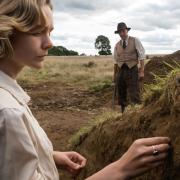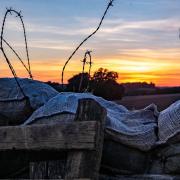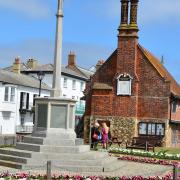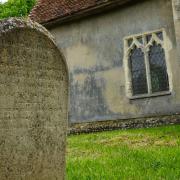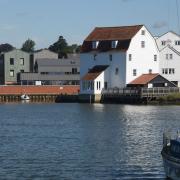A spooky black hound dog, a quirky house in the clouds, mysterious Cold War relics and a lost town under the waves – discover weird and wonderful Suffolk

Suffolk’s coast is scattered with unusual and intruiging buildings, statues, folkloric symbols, engineering feats and artistic works. Here are just a few you might come across. . .
1) House in the Clouds
One of the country’s great follies, The House in the Clouds at Thorpeness is actually a water tower, built in 1923 to receive water pumped from Thorpeness Windmill. To make it more aesthetically appealing its tank was given a weatherboard disguise in keeping with the Edwardian resort’s mock-Tudor and Jacobean style created by Glencairn Stuart Ogilvie in the 1920s. The ‘house’ – 85 steps from top to bottom and around 70ft high – seems to float above the trees. The original capacity of the water tank was 50,000 imperial gallons (230,000 litres) but during the Second World War, the House in the Clouds was hit by gunfire from anti-aircraft guns based at Thorpeness. The water tank was repaired using its own steel, which resulted in a reduced capacity of 30,000 imperial gallons (140,000 litres).

By 1977 the water tower was redundant after mains water came to the village and insubsequent years the main water tank was removed and the building fully converted into a house. Grade II Listed since 1995, it’s currently used as holiday accommodation and has five bedrooms. houseintheclouds.co.uk/
2) Lowestoft Bascule Bridge
Lowestoft is known for many things – it’s England’s most easterly point, it has wonderful sandy beaches, two piers, a lighthouse and a museum dedicated to the town’s fishing heritage. But the bascule bridge is one of its most fascinating features.

Since the 1830s, when a canal was cut from the sea to Lake Lothing to make passage for bigger ships bringing trade to Lowestoft, there have been several bridges built to cross it. First a bridge, then a swing bridge, followed by a second swing bridge when the first wore out, until finally the bascule bridge that’s there today. As is often the way, each one was obsolete as soon as it opened, as traffic increased and the demands on it became greater. Today’s bridge has been in place since 1972 and is already past its expected lifespan of 30 years. It’s a source of frustration for locals who every time it breaks down and brings the town to a halt, and they’re desperate for a new one, but it’s fascinating to watch and a great piece of engineering.
3) Aldeburgh Moot Hall
Quirky Aldeburgh Moot Hall could be another coastal folly but it’s far from purely decorative. Built in 1520, the Grade I listed, timber-framed building was used for council meetings for over 400 years. Moot (‘meet’) halls have been around since Anglo Saxon times though they were simpler earthworks in those days. Aldeburgh Moot Hall now houses the superb Aldeburgh Museum. aldeburghmuseum.org.uk/

4) Snooks
Aldeburgh’s much-loved dog Snooks has quite a tale to tell. The statue of Snooks was originally installed next to the model yacht pond in 1961 to honour his owner, local GP Dr Robin Acheson, who cared for the community from 1931 to 1959. Snooks followed his master as he made his calls and became a familiar sight around the town. But the statue ‘disappeared’ in February 2003 causing much upset in the town. A large fundraising effort followed and an exact replica was cast as a replacement.
Then, in July 2012, the original was returned to Aldeburgh after being discovered by antiques dealer John O’Connor. Aldeburgh Town Council voted to permanently lend the original Snooks to Aldeburgh Hospital League of Friends who placed it in the garden of the hospital.

5) Martello Towers
We love these chunky, round towers that are such a distinctve feature of the Suffolk coast – but what are they? Martellos are small defensive forts that were built across the British Empire during the 19th century, from the time of the French Revolutionary Wars onwards. They stand up to 40 feet (12m) high, and typically had a garrison of one officer and 15–25 men. They were inspired by a round fortress at Mortella (Myrtle) Point in Corsica. Their round structure and thick walls of solid masonry made them resistant to cannon fire, while their height made them an ideal platform for a single heavy artillery piece able to fire over a complete 360° circle. They became obsolete with the introduction of powerful rifled artillery.
There were originally 29 Martello towers built along the east coast of the UK between 1808 and 1812. from St Osyth in Essex to Aldeburgh in Suffolk. Originally there were 11 in Essex and 18 in Suffolk. The towers are identified by letter – Felixstowe is home to towers L to U, towers V to Y are at Bawdsey, Alderton has tower Z, AA is at Shingle Street, BB by the River Ore and CC at Aldeburgh.

Martello V was demolished and used as a sunken garden for Bawdsey Manor in late 1800s. Martello X at Bawdsey was washed into the sea inthe early 20th century, and Martello BB demolished in 1822. Most surviving Martellos are now in private ownership, either unused or converted to houses.
6) Orford Ness
Orford Ness is several curiosities in one unique location. A wild, remote shingle spit – the largest in Europe – it is an internationally important nature reserve with vegetated shingle, brackish lagoons, reed marshes, salt marsh and mudflats that support rare and important plant, animal, insect and bird species. But what are those strange buildings and masts? Strange in such a fragile, natural environment, yet they look oddly at home. Orford Ness is littered with mysterious debris and buildings from the past, much of it to do with its role as a military site from the days of Napoleon to the Second World War.
In 1913 the War Department acquired a large part of the Ness to develop into airfields. Orford Ness was a hive of activity, working on all aspects of how to use a plane as a weapon. Over the next several decades it was the site for experiements in bomb ballistics, homing beacons and radar, work which almost certainly influenced the course of the Second World War. Firing trials took place to determine the vulnerability of aircraft and their components. The information gathered was used to improve aircraft and munitions design and helped many aircrew to make it home. After 1945 lethality and vulnerability trials continued and also work on the aerodynamics of ammunition. Ballistics testing included rockets with jets firing from almost no altitude into the King’s Marsh. Later on the Ness hosted one of its largest secrets, the huge Cobra Mist radar project.
At the height of the Cold War the Atomic Weapons Research Establishment and the Royal Aircraft Establishment (AWRE) used Orford Ness for development work on the atomic bomb. In the 1960s ominous half-buried concrete structures were built to contain these most lethal of weapons. From the 1970s the RAF Explosive Ordnance Disposal (EOD) destroyed large quantities of munitions. The last service personnel to be based on site left in 1987and the Ness remained officially closed to the public. In 1993 the Ministry of Defence sold Orford Ness to the National Trust which now cares for the spit’s natural and historic features and hosts public visits. nationaltrust.org.uk/orford-ness-national-nature-reserve
7) Dunwich
Dubbed ‘Britain’s Atlantis’ the coastal village of Dunwich was once an important medieval city with a population of 4,000, until coastal erosion gnawed away at it and much of it crumbled into the sea. Towards the end of the 1300s particularly ferocious storms wiped out around 400 homes and two churches. It is said that on stormy nights you can hear church bells ringing beneath the waves...
Read a sailor’s final farewell to Orfordness Lighthouse
8) Landguard Fort
What a curiosity this is. An 18th century fort with some very strange 20th century additions. Landguard Fort defended the approach to Harwich Harbour and was the site of the last opposed seaborne invasion of England, by the Dutch in 1667, who were repulsed by the Royal Marines in their first land battle. It was manned through both World Wars and played an important anti-aircraft role during the Second World War – hence the odd looking concrete gun casements at the front. In 1951 two of them were converted into a ‘Cold War’ control room. The fort was disarmed and closed in 1956. Felixstowe Museum, next door, is housed in a former submarine mining establishment, part of Landguard’s defences. Run by the Royal Engineers, the purpose-built brick Ravelin Block of 1877-80, included facilities for assembling, installing – via a narrow-guage tramway to a jetty with a specially-adapted boat – and electronically detonating the mines.
9) Bawdsey Radar
It’s hard not to be curious about what went on at the red brick manor standing proudly on the Bawdsey peninsula. It was here, on September 24, 1937, that RAF Bawdsey became the first fully operational radar station in the world, just 18 months after the first experiment conducted by Robert Watson Watt and Arnold Wilkins. They had started at Orford Ness in 1935 but it soon became clear that it was inadequate for further research and they moved into the Bawdsey Manor Estate in February 1936. Stables and outbuildings were converted into workshops, 240ft wooden receiver towers and 360ft steel transmitter towers were built and Bawdsey became the first Chain Home Radar Station. It played a viatl role in the Second World War and was used as an RAF base through the Cold War until the 1990s when the Bloodhound Missile was the last ‘tenant’ in the base. The RAF station closed on March 31 1991 and the last of the giant transmitter masts came down in 2000. Find out more at https://www.bawdseyradar.org.uk/
10) The Black Dog
Blythburgh Holy Trinity Church is one of the great sights along the Suffolk coast, perched above the basin where the River Blyth makes its spectacular final, snakelike meanderings to the sea. It’s curious as to why this tiny village should be blessed with such a magnificent place of worship, a cathedral in the marshes. But up close, the really curious thing are the scorch marks on the door, said to be evidence of the giant claws of Black Shuck, a legendary hellhound believed by many to be the inspiration Sherlock Holmes’ Hound of the Baskervilles. Black Shuck (‘devil’ or ‘fiend’, from Old English ‘scucca’), also known as the Bungay Black Dog, is infamous for haunting the coastline and countryside around Blythburgh and Bungay. According to Abraham Fleming’s 1577 account, during a tremendous storm, the beast – enormous, black and shaggy, with fiery eyes – burst through the doors of St Mary’s church in Bungay to a clap of thunder, ran up the nave, past a large congregation, killing a man and boy and causing the church steeple to collapse through the roof. The dog then fled, reaching Blythburgh Church where it mauled and killed more people, and left scorch marks – “the devil’s fingerprints” – on the north door which can be seen to this day. According to folklore, Black Shuck now prowls the dark lanes and coastal country footpaths, visiting churchyards at midnight, silent underfoot. . . but issuing a blood-curdling howl.
11) Southwold lighthouse
There are lots of curious things about Southwold – it’s eccentric pier with its wacky Under the Pier Show, it’s expansive greens – land left vacant after a disastrous blaze in 1659 destroyed most of the town and damaged St Edmunds Church – its historic brewery, its six 18-pounder cannon which commemorate the 1672 Battle of Sole Bay, in which the English and French fleets fought off the Dutch, no doubt cheered on by Southwold townsfolk from the cliff top. But it’s the lighthouse which always raises a smile among visitors to the town. It nestles in Southwold’s winding backstreets, among quaint cottages – that is if something 102 ft tall (31 metres) (102 ft), standing 121ft (37 metres) above sea level is capable of nestling – a gleaming white beacon that is more familiarly found on an isolated cliff top or rocky outcrop. But here it is, part of the fabric of the town, earning its keep as a warning to shipping – its beam extends 24 nautical miles (44 km/28 miles) – and as a visitor attraction. Owned by Trinity House, the lighthouse is Grade II listed, and guided visits are run by the Southwold Millennium Foundation. Cheerful, willing volunteers will lead you up 113 steps around a spiral staircase for a view from the top.
12) The Scallop
Who wouldn’t be curious Maggi Hambling’s Scallop, which has stood proudly on Aldeburgh beach since 2003? The four metres high steel sculpture is a tribute to the composer Benjamin Britten who was born in Lowwestoft an lived and worked in and around Aldeburgh for most of his life. Scallop attracted a not inconsiderable amount of controversy in its early days over its positioning on an otherwise deserted stretch of shingle beach. It is now part of the landscape, a favourite subject for photographers, a tactile thing that delivers something different from every angle that it’s viewed. Pierced with the words “I hear those voices that will not be drowned” from Britten’s opera Peter Grimes, it is described by Hambling as a conversation with the sea and won her the 2006 Marsh Award for Excellence in Public Sculpture. It divides opinion (as art generally does) – you make up your own mind...





